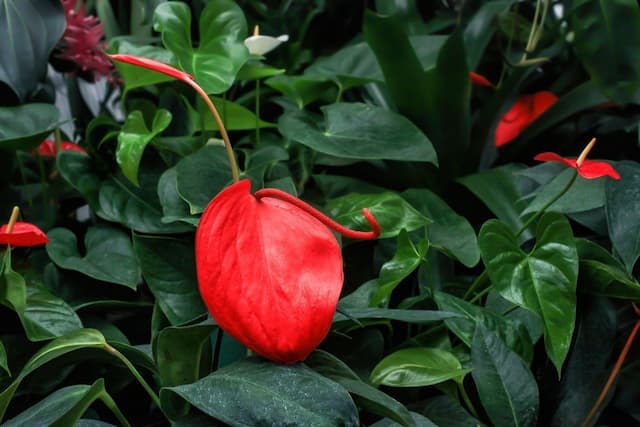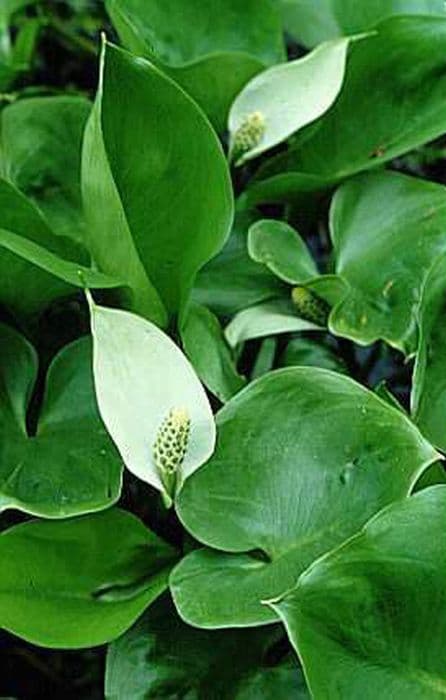Dumb Cane Dieffenbachia 'Tropic Snow' (v)

ABOUT
Dieffenbachia 'Tropic Snow', commonly known as Dumb Cane, is a striking houseplant with broad, lush leaves that have a tropical appearance. The foliage of this plant is notable for its creamy-white to yellow center and deep green margins with intricate variegation. The leaves are large, elongated, and pointed at the tips with wavy edges, creating an attractive pattern that contrasts beautifully with the various shades of green. The Dumb Cane has a sturdy and erect stem that supports the weight of the heavy leaves, which grow in a spiraling pattern up the length of the stalk. The creamy white sections often contain speckles or streaks of green, adding to the visual interest of the plant. The overall appearance of the Dieffenbachia 'Tropic Snow' is lush, vibrant, and can add a touch of the tropics to any indoor setting.
About this plant
 Names
NamesFamily
Araceae.
Synonyms
Dumb Cane, Leopard Lily, Tropic Snow, Mother-in-law's Tongue.
Common names
Dieffenbachia 'Tropic Snow'
 Toxicity
ToxicityTo humans
Dumb cane, which includes the 'Tropic Snow' variety, contains calcium oxalate crystals that are highly toxic when ingested. The symptoms of poisoning include intense burning and swelling of the mouth, tongue, and lips. Difficulty swallowing, excessive drooling, and vomiting can also occur. In severe cases, the swelling can impede breathing, which may become an emergency situation.
To pets
Dumb cane toxicity to pets is similar to its effect on humans. The ingestion of any part of the plant can cause symptoms such as oral irritation, intense burning and irritation of the mouth, tongue, and lips, excessive drooling, vomiting, and difficulty swallowing. In severe cases, the airway can become swollen, potentially leading to difficulty breathing necessitating immediate veterinary attention.
 Characteristics
CharacteristicsLife cycle
Perennials
Foliage type
Evergreen
Color of leaves
Variegated
Height
3-5 feet (0.91-1.52 meters)
Spread
2-3 feet (0.61-0.91 meters)
Plant type
Herb
Hardiness zones
10-12
Native area
South America
Benefits
 General Benefits
General Benefits- Easy to Care For: Dieffenbachia 'Tropic Snow' is adaptable and can thrive with minimal attention, which makes it suitable for beginners or those with a busy schedule.
- Interior Decoration: Its large, variegated leaves make it an attractive addition to indoor spaces, enhancing the aesthetic of home or office environments.
- Shade Tolerant: The plant is capable of growing in low-light conditions, allowing it to be placed in less sunny areas where other plants might struggle.
- Humidity Tolerance: It can tolerate higher humidity levels, making it a good choice for bathrooms and kitchens.
- Fast Growing: Dieffenbachia 'Tropic Snow' has a relatively quick growth rate, providing a rewarding experience as it quickly fills in space and transforms an area.
- Large Foliage: The plant's expansive leaves can add a touch of the tropics to an indoor setting, contributing to a more relaxing and natural atmosphere.
 Medical Properties
Medical PropertiesThis plant is not used for medical purposes.
 Air-purifying Qualities
Air-purifying QualitiesThis plant is not specifically known for air purifying qualities.
 Other Uses
Other Uses- Visual Barrier: 'Tropic Snow' can be used to create a natural green screen in office spaces, providing privacy and dividing areas without the need for walls.
- Photography Backdrop: The large, variegated leaves can serve as a tropical-themed backdrop for product photography or portrait sessions.
- Educational Tool: Due to its fast growth and easy care, 'Tropic Snow' can be used in classrooms to teach children about plant growth cycles and horticulture.
- Sound Absorption: The dense foliage of 'Tropic Snow' can help dampen noise in echo-prone rooms, aiding in creating a quieter environment.
- Humidity Creator: By grouping several 'Tropic Snow' plants together, one can increase the humidity of a room, which is beneficial in dry climates or during winter months.
- Staging Decor: Real estate agents can utilize 'Tropic Snow' to enhance the appeal of properties during open houses and staging by adding a touch of greenery.
- Feng Shui Element: 'Tropic Snow' can be used to add the wood element into a space according to Feng Shui principles, promoting vitality and growth.
- Theater Prop: In plays and theaters, 'Tropic Snow' can serve as a prop to create a tropical or jungle scene on stage.
- Theme Parties: For tropical or jungle-themed parties, 'Tropic Snow' can be integrated into the decor to enhance the atmosphere.
- Art Inspiration: Artists can draw inspiration from the patterns and structure of the 'Tropic Snow' leaves, leading to unique botanical-themed artworks.
Interesting Facts
 Feng Shui
Feng ShuiDumb Cane is used in Feng Shui for its broad leaves, which are believed to help purify the air and remove toxins, contributing to good health and positive energy flow within a space. It should be placed in areas that need an uplift in energy, such as dark corners, to bring in light and life energy or Chi. However, care must be taken to keep the plant out of reach from children and pets, as it is toxic when ingested.
 Zodiac Sign Compitability
Zodiac Sign CompitabilityThe Dumb Cane is not used in astrology practice.
 Plant Symbolism
Plant Symbolism- Growth: Often associated with personal growth due to its quick and lush expansion, it symbolizes one's capacity for emotional and intellectual development.
- Camouflage: The Dieffenbachia's patterned leaves can be seen as symbolic of our need to blend in or stand out from our surroundings, depending on the situation.
- Harmony: With its balanced variegation, the plant represents harmony and the idea of bringing different elements together to create a peaceful environment.
- Vibrancy: Its lively green color is often a sign of vitality and vigorous life, signifying the presence of dynamic energy in one’s space.
- Healing: In some cultures, plants are seen as a symbol of healing and nurturing, providing comfort and improving the healing environment.
 Water
WaterDumb Cane should be watered when the top inch of soil feels dry to the touch, which usually amounts to once a week. It's important to water thoroughly, pouring water evenly around the entire pot until it begins to drain out of the bottom, indicating the soil is fully saturated. During the winter months, reduce watering frequency as plant growth slows down. On average, a six-inch pot may require around 8 ounces of water per week under normal indoor conditions, but always adjust for your specific environment and the plant's needs.
 Light
LightDumb Cane thrives in bright, indirect light but can tolerate lower light conditions as well. It should be placed in a location that receives filtered sunlight, avoiding direct sun exposure that can scorch its leaves. The ideal spot would be near a window with sheer curtains to diffuse the light or in a well-lit room without direct sun hitting the plant.
 Temperature
TemperatureDumb Cane prefers warm conditions with temperatures ranging between 65 and 75 degrees Fahrenheit. It can survive a minimum temperature of 60 degrees Fahrenheit but should not be exposed to temperatures below this as it can cause stress to the plant. Avoid placing the plant near drafts or sources of cold, such as air conditioning vents or windows during winter.
 Pruning
PruningDumb Cane should be pruned to remove yellow or damaged leaves and to maintain its shape. Prune sparingly, as excessive cutting can stress the plant. The best time to prune is in the spring when the plant begins to show new growth. Use clean, sharp shears to make precise cuts, and always prune just above a leaf node. Pruning once or twice a year is typically sufficient, but this may vary depending on the growth rate of your specific plant.
 Cleaning
CleaningAs needed
 Soil
SoilDumb Cane thrives in a well-draining soil mix with peat, perlite, and pine bark. The ideal soil pH is between 6.1 and 6.5.
 Repotting
RepottingDumb Cane should be repotted every 1-2 years to ensure continued growth and to refresh the soil.
 Humidity & Misting
Humidity & MistingDumb Cane prefers humidity levels around 60-80%, which mimics its natural tropical habitat.
 Suitable locations
Suitable locationsIndoor
Place Dumb Cane in bright, indirect light and away from drafts.
Outdoor
Grow Dumb Cane in shade to part-shade in warm climates.
Hardiness zone
10-12 USDA
 Life cycle
Life cycleThe Dumb Cane 'Tropic Snow' starts as a seed that once planted in a warm, moist environment, germinates and sprouts into a seedling. As it grows, it develops large, patterned leaves and a strong central stem, entering the vegetative stage. With adequate light, water, and nutrients, it matures into a robust plant. In its adult phase, under ideal conditions, it may produce a spadix flower surrounded by a spathe, though flowering is rare in domestic settings. After flowering, it may produce berries containing seeds, completing its reproductive cycle. Over the years, the plant may become leggy, at which point propagation through cuttings can rejuvenate it and start the life cycle anew with the next generation of plants.
 Propogation
PropogationPropogation time
Spring to Summer
The most popular method of propagating the Dieffenbachia 'Tropic Snow', commonly known as Dumb Cane, is through stem cuttings. To propagate Dumb Cane, select a healthy section of stem that includes at least one node, a part of the stem from which leaves emerge. The cutting should be about 4 to 6 inches long (10 to 15 cm). After cutting, allow the section to air dry for a few hours to let the cut end form a callous, which helps prevent rotting. The cutting can then be planted directly into a pot filled with a well-draining potting mixture. It should be placed in indirect light and kept uniformly moist, but not waterlogged, until new growth indicates that the cutting has successfully rooted, which typically takes several weeks.









